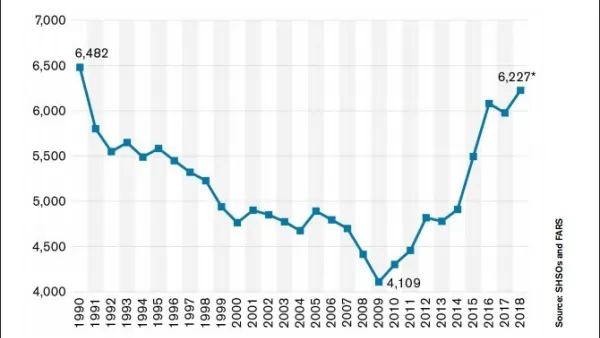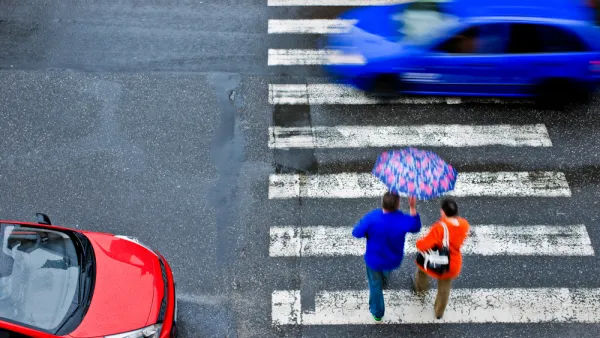New Mexico had the nation's highest pedestrian fatality rate in 2014. Alcohol was a factor in over half the pedestrian fatalities in New Mexico, while nationally it's a third. According to the Albuquerque PD, drunk pedestrians are primarily to blame.

"New Mexico racked up 74 pedestrian fatalities in 2014, or a rate of 3.55 per 100,000 residents, according to a report issued in May by the National Highway Traffic Safety Administration (NHTSA)," writes Olivier Uyttebrouck for the Albuquerque Journal. "That was more than twice the U.S. rate of 1.53 per 100,000."
“Pedestrian impairment” is the key factor in fatal pedestrian crashes in Albuquerque, said Tanner Tixier, a spokesman for the Albuquerque Police Department. “The majority of our pedestrian fatalities are a result of intoxicated pedestrians walking outside of safety areas, and not the result of drivers being at fault,” he said.
"Outside of safety areas" is another way of saying the pedestrians were jaywalking.
Only 21 percent of pedestrians, or about one in five, were killed at intersections in 2014, it said. Most were killed crossing streets away from intersections, and a small number were killed on medians, sidewalks and roadsides.
Nexus with homelessness?
Many of Albuquerque’s homeless population “are perpetually intoxicated and aren’t looking out for cars in the middle of the night,” Tixier said. Too often, pedestrians meet their end crossing streets outside of crosswalks in dimly lit areas, he said
Whether jaywalking, intoxicated, or distracted by cell phones (which the article did not discuss), there are still ways to reduce pedestrian fatalities, e.g., street design improvement, adding lighting, and reducing speed limits, which the New Mexico Department of Transportation (DOT) is doing.
DOT incorporates safety features into its roadway designs, including sidewalks, lighting and pedestrian refuge islands, the statement said. The agency also sponsors an advertising and media campaign to encourage pedestrians, bicyclists and motorists to stay vigilant on the road.
Fatalities occurred mostly in urban and Native American areas
Two counties accounted for 59 percent of the states pedestrian fatalities: Bernalillo County, the most populous where Albuquerque, the state's largest city is located, and McKinley County, in the northwest, with 75.5% Native American population.
Of all traffic deaths in Bernalillo County that year, 40 percent were pedestrians. Statewide, pedestrians comprised 17 percent of all traffic deaths in 2013.
Of the 38 Bernalillo County pedestrians killed from 2008 to 2011, half were intoxicated, according to a 2014 study by the Mid-Region Council of Governments.
New Mexico was followed by Florida, Delaware, Nevada, and Louisiana in pedestrian fatality rates (see chart for 2014 rates).
2015 preliminary data: Pedestrian deaths up, motorists deaths down
See Planetizen post last March based on Governors Highway Safety Association (GHSA) report, "Pedestrian Traffic Fatalities by State." "2015 saw a 10 percent increase in pedestrians killed in motor vehicle crashes compared to a four percent decline in overall traffic deaths during the same period." Note different figures reported by the National Safety Council.
FULL STORY: New Mexico is No. 1 in pedestrian deaths

Analysis: Cybertruck Fatality Rate Far Exceeds That of Ford Pinto
The Tesla Cybertruck was recalled seven times last year.

National Parks Layoffs Will Cause Communities to Lose Billions
Thousands of essential park workers were laid off this week, just before the busy spring break season.

Retro-silient?: America’s First “Eco-burb,” The Woodlands Turns 50
A master-planned community north of Houston offers lessons on green infrastructure and resilient design, but falls short of its founder’s lofty affordability and walkability goals.

Test News Post 1
This is a summary

Analysis: Cybertruck Fatality Rate Far Exceeds That of Ford Pinto
The Tesla Cybertruck was recalled seven times last year.

Test News Headline 46
Test for the image on the front page.
Urban Design for Planners 1: Software Tools
This six-course series explores essential urban design concepts using open source software and equips planners with the tools they need to participate fully in the urban design process.
Planning for Universal Design
Learn the tools for implementing Universal Design in planning regulations.
EMC Planning Group, Inc.
Planetizen
Planetizen
Mpact (formerly Rail~Volution)
Great Falls Development Authority, Inc.
HUDs Office of Policy Development and Research
NYU Wagner Graduate School of Public Service




























